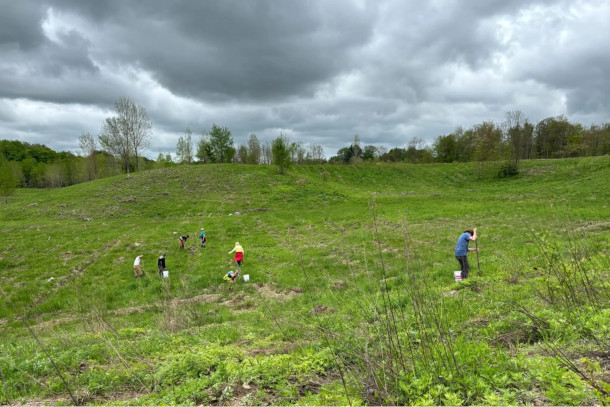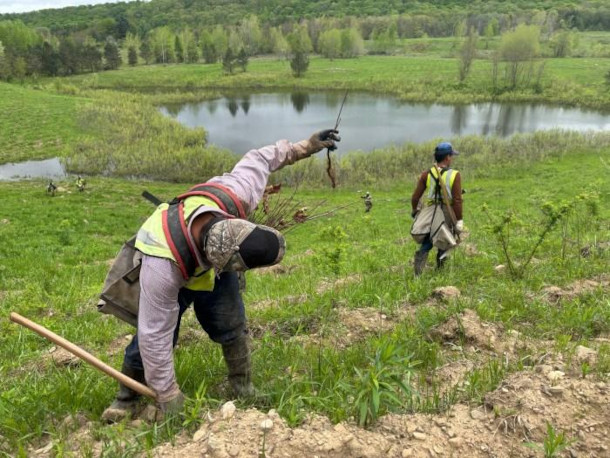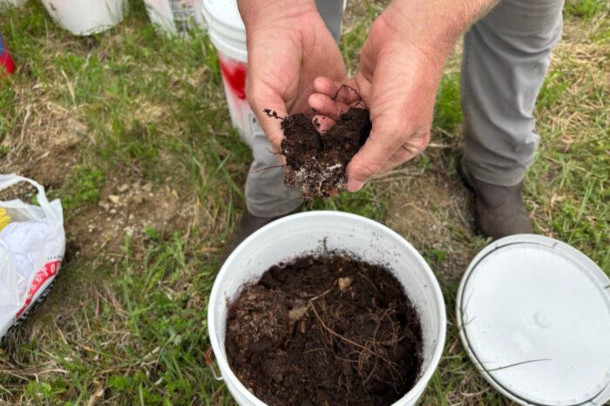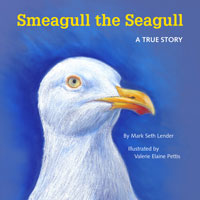Reforesting a Gravel Mine
Air Date: Week of May 30, 2025

Lake Pleasant Conservation Area was once a gravel mine, but is now being replanted with hardwood trees. (Photo: Kyra McCague, Courtesy of the Allegheny Front)
At a former gravel mine in northwestern Pennsylvania, nonprofits are working to plant 70,000 trees as part of a larger project to reforest thousands of acres of degraded mine land in the region. The Allegheny Front’s Kara Holsopple reports on how they’re experimenting with fungi and biochar to help restore degraded soil and give the saplings a head start.
Transcript
BELTRAN: Lake Pleasant in northwestern Pennsylvania was created over 15,000 years ago when a glacier retreated. Since the 1990s, the Western Pennsylvania Conservancy has been buying and conserving land around the lake, which supports rare plants and birds like osprey. The Allegheny Front’s Kara Holsopple reports that now a nonprofit is helping the conservancy reforest a problem area on the property.
[AMBI OUTDOORS NEAR ROAD]
[NAT WALKING]
HOLSOPPLE: Michael Knoop walks down a hillside in the Lake Pleasant Conservation Area in Erie County. This section was an old gravel mine, and now the Western Pennsylvania Conservancy owns it. We have to watch our step…
KNOOP: There's trees planted in this burrow right here, so if you stay to the left and right of it, we should be okay. I'm just going to show you one of the trees. This is what they look like when they go in.
HOLSOPPLE: It’s just a 8-inch-stick with a teeny green leaf at the top. Knoop is vice president of Bosland Growth a nonprofit that partners with landowners–in this case, the conservancy–to reforest land. Here, the trees will create wildlife habitat and improve water quality. But there’s a problem. The soil here is poor.
KNOOP: The regulations require the companies to return the landscape to relatively the same contours that they had been before mining, and to do that, they have to use heavy equipment that compacts the soil a lot more than is healthy for trees to grow in.
HOLSOPPLE: So, to treat the compacted soil and prepare for planting, Knoop says, last fall, a company ripped down into the ground about three feet with machinery, creating a checkerboard pattern across the landscape. Knoop is leading me and a group of project partners and guests today towards two experimental plots on the property, where they’re testing different ways to improve the tree growth here. We pass a team of workers, swinging hoedads, long spades used to make a hole in the ground, and popping the little trees in.

The 100 acres of the property will have 70,000 trees planted on it by workers from Williams Forestry and Associates. (Photo: Kyra McCague, Courtesy of the Allegheny Front)
[NAT OF WORKERS]
HOLSOPPLE: This crew is planting 70,000 trees here this week. That’s no small feat on this 100-acre section of the property the conservancy purchased in 2006. Knoop says they’re planting white pine, black locust, scarlet oak, and red maple on the site. And in the bottom land, swamp white oak, sycamores and silky dogwood–trees he says like to get their feet wet. There’s already water on the property. It’s dotted with small ponds. Andy Zadnik, Director of Land Stewardship for Western Pennsylvania Conservancy, says they are actually the pits left by the mining company…
ZADNICK: They really shouldn't be here.
HOLSOPPLE: Zadnick says Lake Pleasant is the finest example of an inland glacial lake in the state. It’s mainly fed by groundwater, so the water collecting in these pits could be impacting the water chemistry and temperature in the nearby lake. The pits are also infested with an invasive aquatic plant called Eurasian watermilfoil – the conservancy is treating the ponds for the plant which hasn’t made it to the lake yet…
ZADNICK: We're taking a really long-term view that we're hoping that if we can restore a healthy forest on this property in time, these pits might start to fill in or become more scrub-shrub wetlands and less these open water areas.
HOLSOPPLE: In the shorter term, the reforestation partners are hoping for a 70% survival rate for the trees over the next few years. Bosland Growth combines grant funding from government and philanthropic organizations with revenue from the sale of carbon credits to pay for the reforestation. They need healthy, growing trees here as a base for those carbon credits. Here’s where the experiment comes in. On one two-and a half acre section they’re partnering with the biotech company Funga. Josh Parrish, Chief Growth Officer at Funga, combs his fingers through some dirt in a 5-gallon plastic bucket to explain.
PARRISH: There's like little fine, here, you can see like fine white roots.
HOLSOPPLE: These are the fungal roots or “fungal hyphae”.
PARRISH: The fungi break down all of the nutrients and then the fungi pass on the nutrients to the tree roots, to the fibrous, little, tiny tree roots through the fungal hyphae.
HOLSOPPLE: Parrish says nearly all trees require a below-ground fungus partner, to grow. His company tested the soil here for signs of life – to see how degraded the microbiome has become after all of the industry and land disturbance. They also took multiple samples of soil from healthy forest land. Then Funga uses machine learning and DNA sequencing to predict what kind of soil microbiome would make the trees they’re planting here healthier and more productive. Under each tree goes a handful of the healthy soil from one of the buckets.

Funga, a biotechnology company, makes efforts to improve soil quality via a combination of machine learning and DNA sequencing to predict what kind of soil microbiome would be most beneficial to the trees being planted. (Photo: Kyra McCague, Courtesy of the Allegheny Front)
PARRISH: By putting this with the tree at time of planting, you're essentially giving the trees the best chance possible at survival and growth because you're giving them that essentially the right partners.
HOLSOPPLE: Some of the rich soil comes from other Western Pennsylvania Conservancy forested properties. This is Funga’s first hardwood restoration trial in the US. Just over a little hill is a second experimental plot, where trees are being planted with another material: biochar. It’s a medium fine black powder and is a byproduct of the logging industry. It’s porous and helps trees retain water and pick up nutrients from the soil. It gives those microbes and fungi a space to colonize, too. Brenda Costa is scooping biochar from a bucket with a red Solo cup, as her colleague digs a hole with a shovel to prepare the soil. Costa is the executive director of the French Creek Valley Conservancy.
[NAT SCOOPING AND DIGGING SOUND]
COSTA: You know, Lake Pleasant is a really important feature or place within our watershed. And so, this additional effort to try to protect it is pretty great.
HOLSOPPLE: Lake Peasant is part of the headwaters of French Creek, an important habitat for freshwater mussels, including some endangered species. Michael Knoop from Bosland Growth says they’ll monitor the experiments over the next few years to see what’s most effective. The Lake Pleasant project with the Western Pennsylvania Conservancy is Bosland’s first project toward their goal of reforesting 2,800 acres of degraded mine land in Ohio, Pennsylvania, and West Virginia.
KNOOP: So, t's a gigantic opportunity to return native forest to a huge amount of land across the region.
HOLSOPPLE: Knoop says they have signed up a handful of private landowners to work with in Pennsylvania and West Virginia over the next couple of years.
BELTRAN: That’s Kara Holsopple reporting for the Allegheny Front.
Links
Living on Earth wants to hear from you!
Living on Earth
62 Calef Highway, Suite 212
Lee, NH 03861
Telephone: 617-287-4121
E-mail: comments@loe.org
Newsletter [Click here]
Donate to Living on Earth!
Living on Earth is an independent media program and relies entirely on contributions from listeners and institutions supporting public service. Please donate now to preserve an independent environmental voice.
NewsletterLiving on Earth offers a weekly delivery of the show's rundown to your mailbox. Sign up for our newsletter today!
 Sailors For The Sea: Be the change you want to sea.
Sailors For The Sea: Be the change you want to sea.
 The Grantham Foundation for the Protection of the Environment: Committed to protecting and improving the health of the global environment.
The Grantham Foundation for the Protection of the Environment: Committed to protecting and improving the health of the global environment.
 Contribute to Living on Earth and receive, as our gift to you, an archival print of one of Mark Seth Lender's extraordinary wildlife photographs. Follow the link to see Mark's current collection of photographs.
Contribute to Living on Earth and receive, as our gift to you, an archival print of one of Mark Seth Lender's extraordinary wildlife photographs. Follow the link to see Mark's current collection of photographs.
 Buy a signed copy of Mark Seth Lender's book Smeagull the Seagull & support Living on Earth
Buy a signed copy of Mark Seth Lender's book Smeagull the Seagull & support Living on Earth

